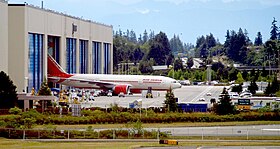Production and testing
The production process included substantial international content, with an unprecedented level of global subcontracting for a Boeing jetliner,[37] exceeded only by the later 787.[38] International contributors included Mitsubishi Heavy Industries and Kawasaki Heavy Industries (fuselage panels),[39] Fuji Heavy Industries, Ltd. (center wing section),[39] Hawker de Havilland (elevators), andAerospace Technologies of Australia (rudder).[40] An agreement between Boeing and the Japan Aircraft Development Corporation, representing Japanese aerospace contractors, made the latter risk-sharing partners for 20 percent of the entire development program.[37] The initial 777-200 model was launched with propulsion options from three manufacturers, General Electric, Pratt & Whitney, and Rolls-Royce,[41] giving the airlines their choice of engines from competing firms.[42] Each manufacturer had agreed to develop an engine in the 77,000 lbf (340 kN) and higher thrustclass (a measure of jet engine output) to power the world's largest twinjet.[41]
To accommodate production of its new airliner, Boeing doubled the size of the Everett factory at the cost of nearly US$1.5 billion[25] to provide space for two new assembly lines.[27] New production methodologies were developed, including a turn machine that could rotate fuselage subassemblies 180 degrees, giving workers access to upper body sections.[33] Major assembly of the first aircraft began on January 4, 1993.[43] By the start of production, the program had amassed 118 firm orders, with options for 95 more from 10 airlines.[44] Total investment in the program was estimated at over US$4 billion from Boeing, with an additional US$2 billion from suppliers.[45]
On April 9, 1994, the first 777, line number WA001, was rolled out in a series of 15 ceremonies held during the day to accommodate the 100,000 invited guests.[46] The first flight took place on June 12, 1994,[47] under the command of chief test pilot John E. Cashman.[48] This marked the start of an 11-month flight test program that was intended to be more extensive than that of any previous Boeing model.[49] Nine aircraft fitted with General Electric, Pratt & Whitney, and Rolls-Royce engines[47] were flight tested at locations ranging from the desert airfield at Edwards Air Force Base in California[50] to frigid conditions in Alaska, mainly Fairbanks' FAI.[51] To satisfy ETOPS requirements, eight 180-minute single-engine test flights were performed.[52] The first aircraft built was used by Boeing's nondestructive testing campaign from 1994 to 1996, and provided data for the −200ER and −300 programs.[53] At the successful conclusion of flight testing, the 777 was awarded simultaneous airworthiness certification by the U.S. Federal Aviation Administration (FAA) and European Joint Aviation Authorities (JAA) on April 19, 1995.[47]








0 komentar:
Posting Komentar